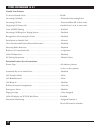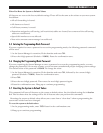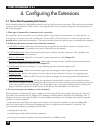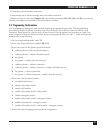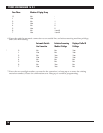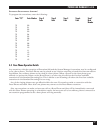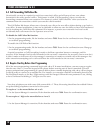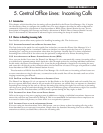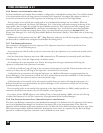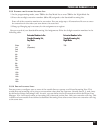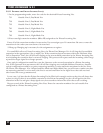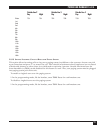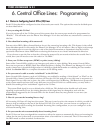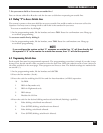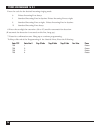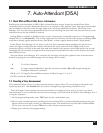
PHONE LINE MANAGER 16 X 4
20
5.2.6 DEFINING THE STANDARD INCOMING LINE
In most installations, all outside lines would be configured as a Standard Incoming Line. You will first define
a list of extensions which will ring when an incoming call is detected. You might also choose to define a
second list of extensions which will ring when an incoming call is detected in the Night Mode.
The operation of an outside line configured to be a Standard Incoming Line is as follows. When an
incoming call is detected, the Phone Line Manager 16 x 4 checks the extensions starting at the top of the
appropriate (day or night) list to find the first available extension. This extension will start ringing. Zero
to nine rings later (see Section 19.15), the Phone Line Manager 16 x 4 will find the next three available
extensions in the list and start ringing them. After 5 to 60 seconds have passed (see Section 19.11), the
Phone Line Manager 16 x 4 will ring an available Rollover Extension (usually a Voice Mail unit or answering
machine).
Additionally, all key phones with the “RP’” (Ring Position) indicator set will also ring when incoming calls
are detected on outside lines configured as Standard Incoming Lines.
5.2.7 T
HE OPERATOR EXTENSION
One extension is designated to be the Operator. The Operator extension is used by the Phone Line
Manager 16 x 4 in the following ways:
Any extension may dial 0 (or 9) to place an intercom call to the Operator or to transfer an outside call to
the Operator.
Only the Day mode Operator may issue a 56 command or a 57 command to manually switch the Phone
Line Manager 16 x 4 into the Night mode or the Day mode.
An incoming call to an extension on a Private Incoming Line that goes unanswered will ring the
Operator’s extension if the Operator is not busy.
A call left on hold too long will ring at the extension which placed it on hold. If that extension does not
answer or is busy, the call will ring at the Operator’s extension if it is not busy.
A call parked at an extension will ring the Operator (or a Rollover Extension, as programmed by the
System Manager) if the extension at which the call is parked does not become available or if the extension
becomes available but does not answer when the phone rings.
A blind transfer of an outside call to an extension which does not answer will ring the Operator (or a
Rollover Extension, as programmed by the System Manager) if the extension to which the call is being
transferred does not answer.
If an incoming caller to an outside line operating in the Auto-Attendant (or DISA) mode specifies an
extension which does not answer, the call will transfer to the Operator.
If no input (either DTMF digits or a fax Calling Tone) is detected during a DISA call, the call will ring
at either the Operator’s or the fax’s extension, as programmed by the System Manager.
5.2.8 T
HE STANDARD INCOMING LIST—WHICH EXTENSION IS THE OPERATOR
The first (non-Rollover) extension in the Standard Incoming List is defined to be the Operator. This means
that if your Standard Incoming Line List directs incoming calls to an Auto-Attendant/Voice Mail, the
Operator will be defined as the next extension in the list after the Voice Mail extensions (because your Voice
Mail extensions would be defined as Rollover Extensions). Since there is a separate list for Day and Night
operation, a different Operator extension can be defined for each mode.



